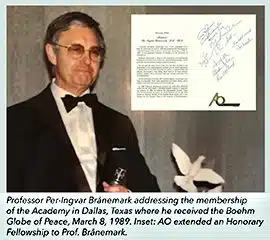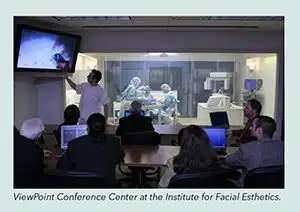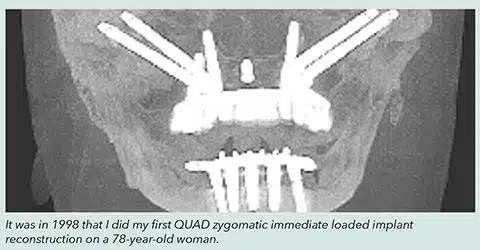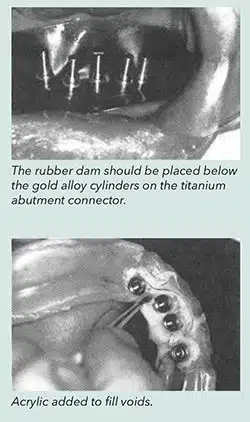By: Thomas J. Balshi, PhD, FACP, Academy News (Guest Contributor)
In the 1970s, Prof. Per-Ingvar Brånemark (PIB) published his 10-year clinical trial with great success, magnetically pulling clinicians from around the world to Sweden to learn the biomechanical details of his treatment protocols.
AO Honorary Fellow George A. Zarb, BChD, DDS, MS, MSc, Prof. and chair of prosthodontics, University of Toronto, verified the value, veracity and efficiency of PIB’s original clinical and laboratory research with his replication study. This led to the eventual FDA and ADA approval of the materials and protocol that set the stage for the 1982 Toronto Conference, opening the door for a small group of North American clinicians to acquire the necessary instruments and fixtures to provide our patients with screw retained fixed prostheses, using PIB’s decade tested, two stage protocol.

In late December, Harry tested the use of the soft lined denture with his 1st stage SCUBA mouthpiece, reporting his disappointment and inability to function well underwater. This situation pushed me to find a solution to accelerate the prosthetic process and provide Harry with a stable prosthetic solution.
At the second stage uncovering procedure, I shortened the PIB prosthetic protocol and avoided placing healing abutments on the implants with circumferential periodontal Pack application and instead installed the only abutment available at that time, the standard Brånemark flat top Ti abutment. At the same time, using a carbon disk, I cut vertical and horizontal retentive grooves into the gold cylinders, since there were no prosthetic cylinders available. The gold cylinders were installed with long guide pins. After applying a rubber dam barrier, I did the first “pick up procedure” connecting the gold cylinders to the temporary acrylic mandibular denture, and created the first “Conversion Prosthesis.” Harry’s dive trip was successful, and I presented this new protocol at the Brussels Conference in 1984, despite the chagrin of PIB and his staunch group of followers.
During the following years our center performed several variations on the concept of immediate loading, published in various journals leading to our center’s “Teeth In A Day™” registered trademark. It was shortly after that, when chairing the AO PR and Awards Committee that I invited PIB to attend the annual session in Dallas, TX, where we awarded him with the Boehm Globe of Peace that U.S. President Ronald Reagan presented to Mikhail S. Gorbachev. PIB built a special display area back in Sweden for this Globe, commenting that it represents the universal concept of caring for all people thru osseointegration. During the early 1990s, we joined with our Swedish colleagues to test the effect of conical shaped and angulated abutments and a variety of prosthetic and impression cylinders. It was during this time period I was invited to Brussels to scrub in with Prof. Chantal Malavez, who worked with PIB in the development of the zygomatic implant as she performed a complex zygomatic surgery. The zygomatic implants were not yet FDA approved and could not be brought into the USA until 1998.
It was at that time that we also opened our educational center at the Institute for Facial Esthetics. The ViewPoint Conference Center consisted of a lecture room with TV studio connected to a large OR equipped with eight robotic cameras and a glass wall that enabled course participants to watch the live surgeries and prosthetic procedures and be able to communicate with the surgical team, all while maintaining a sterile environment.
It was in 1998 that I did my first QUAD zygomatic immediate loaded implant reconstruction on a 78-year-old woman from Georgia.
Then in early 2000s, we were privileged to participate in the development of virtual planning and guided surgery. Initially the 3-D data had to be acquired with a medical grade CAT Scan in a hospital setting. Those scans would have the patient in the scanner for 30 to 45 minutes. However in December of 2004, I received a call from a neighbor, inviting me to look at their engineering invention being manufactured only a short distance from our treatment center. It was our first introduction to CBCT with the iCat CT scanner.
The data (DICOM files) could be quickly moved from the iCat to our laptops to plan the surgery virtually. At the same time, the virtual plan could be digitally printed to produce a surgical guide designed to perform the “Teeth In An Hour™” procedure and invite 50 colleagues to join us for the first course on guided implant surgery. The group stayed an extra day since a winter blizzard closed the Philadelphia airport.
The advent of the zygomatic and pterygomaxillary implants and the ability to virtually plan the implant placement, all but eliminated major bone grafting procedures that were frequently required prior to implant placement. This greatly enhanced and shortened the overall treatment time for full arch implant reconstructions.
During the past decade, our specialty has been blessed to have the advent of the high density and robotically milled dentures (PMMA) making both then the conversion prostheses and the definitive hybrid metal reinforced screw retained prosthesis stronger than those we had previously. This ties in well with the shift toward decreasing the number of implants required for a full arch rehabilitation, resulting in the very common use of the All On 4™ treatment protocol.
At this point in time, implant prosthodontic reconstructions are well understood, taking into account the biomechanical positioning of stabilizing implant fixtures. Additionally, biologic nutrients that fortify and stimulate the development of stronger osseointegration have added to the overall success rate for implant treatment. The future will likely continue to introduce additional benefits in this arena of treatment.
Captions:
Professor Per-Ingvar Brånemark addressing the membership of the Academy in Dallas, Texas where he received the Boehm Globe of Peace, March 8, 1989. Inset: AO extended an Honorary Fellowship to Prof. Brånemark.
ViewPoint Conference Center at the Institute for Facial Esthetics.
The rubber dam should be placed below the gold alloy cylinders on the titanium abutment connector.
Acrylic added to fill voids.
Harry K. conversion prosthesis January 1983, ready for the dive trip.
It was in 1998 that I did my first QUAD zygomatic immediate loaded implant reconstruction on a 78-year-old woman.


